|
THE CSS IRONCLAD RAM ALBEMARLE
HER BATTLES AND VICTORIES
On June 3, 1863, Lieutenant Flusser, commanding the United States steamer Miami, in Albemarle Sound, advised Rear-Admiral S. P. Lee, U.S.N., of the building of a new Confederate. States
ram, the Albemarle, at Edward's Ferry on the Roanoke River,
30 miles below Weldon. The United States navy department several times
called the attention of the general in command of the United States forces
on the sound to the construction of this vessel, and advised that as the United
States ships could not reach her on account of the shallowness of the water, a land force
be sent to burn her. This appeal was disregarded.
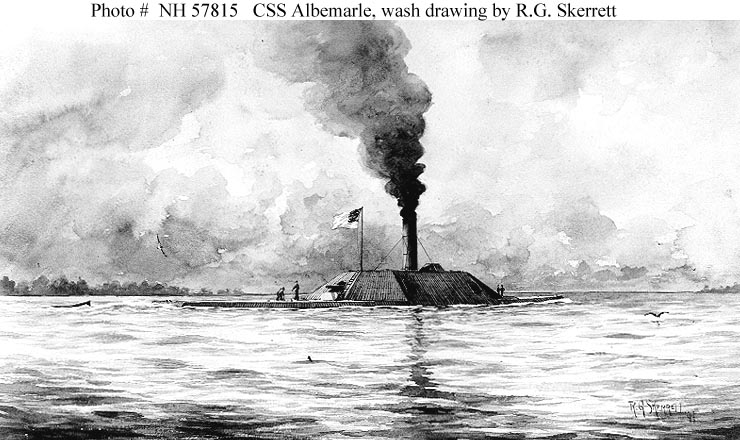
(Picture) CSS Albemarle (1864-1864). Sepia wash drawing by R.G.
Skerrett, 1899. Courtesy of the Navy Art Collection, Washington, DC. U.S. Naval Historical Center Photograph.
| CSS Albemarle: A Civil War Ironclad Ram |
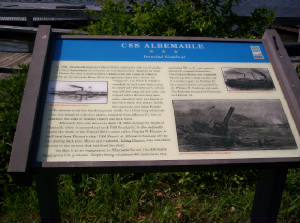
|
| CSS Albemarle: A Confederate Ironclad Ram |
In
the meantime the building of the vessel, subsequently named the Albemarle, went on under the most discouraging circumstances.
There was not even a ship yard at Edward's Ferry; the timber had to be cut in the woods, workmen were scarce, there was no
machine shop, and iron was almost unobtainable. Fortunately, Commander James W. Cooke, C. S. navy, was ordered to assist her
builders, and take command of her when finished. She was simply a flat- bottomed boat, sharp at both ends. The prow was solid
oak, plated with iron; her shield was slanting, and covered with railroad iron, which was sufficient, as after experience
demonstrated. She carried two good guns, Brooke rifles. As the vessel went down in the water, Cooke moved her farther and
farther down the river into deeper water. The officers, crew and workmen suffered great hardships from bad fare, bad water,
and bad climate. But the indefatigable Cooke encouraged them by his example.
By
April, 1863, the vessel was partially completed, and a combined movement against the Federal forces at Plymouth, N. C., was planned. About the middle of April, General Hoke, commander of the Confederate
land forces, visited the ship, then at Hamilton, and Captain Cooke promised to be at Plymouth by the 18th to assist the army. Few men would have ventured
to make the promise. Workmen were still at work; the engine had not been tried, nor the crew drilled. Cooke had, however,
an excellent executive officer in the brave Lieut. F. M. Roby.
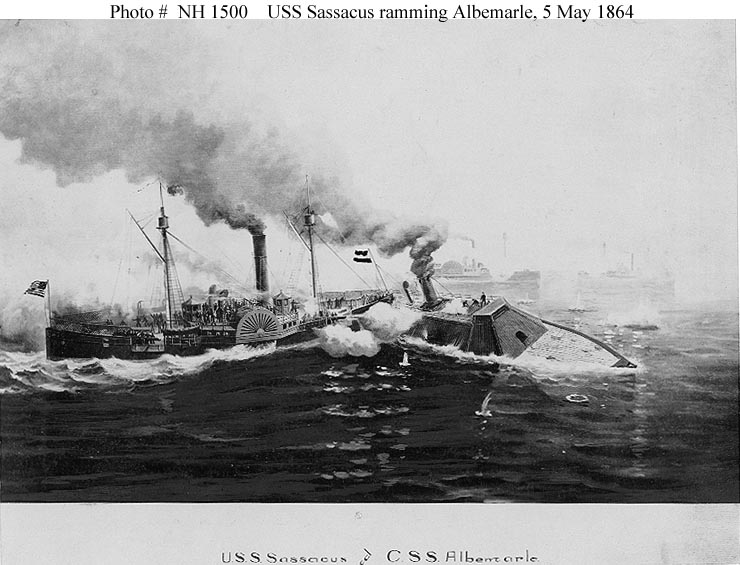
(Picture) "USS Sassacus and CSS Albemarle". It
is a 19th Century photograph of an artwork, depicting USS Sassacus ramming the Confederate ironclad, during Albemarle's
engagement with Federal gunboats on Albemarle Sound, North Carolina, 5 May 1864. Sassacus was hit in a boiler and
disabled during this action. Albemarle was not significantly damaged by the ramming or by gunfire. U.S. Naval Historical
Center Photograph.
| Sinking of Civil War Albemarle Ironclad Ram |
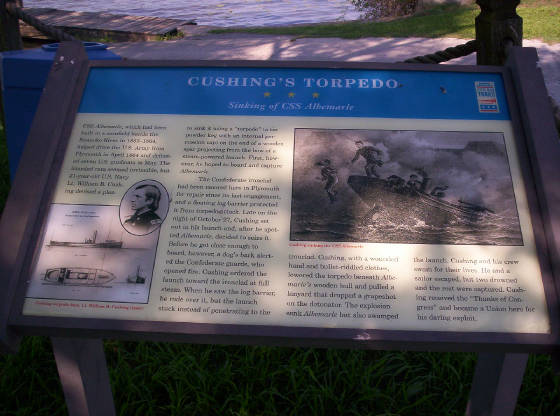
|
| Sinking of Civil War Ironclad Ram Albemarle |
On the 17th and 18th of April, 1864, vigorous attacks were made upon the
forts at Plymouth
by the Confederates under General Hoke. At this time the United States vessels present were the Miami, the Southfield, two
small picket boats, the Bombshell and Whitehead, and the gunboat Ceres, all under the command of Lieutenant Flusser. In Albemarle
Sound were several United States vessels,
technically called double-enders. Captain Flusser helped materially in the defense of the forts on the 17th and 18th; his
two larger vessels carrying one rifled zoo-pounder and five or six 9-inch shell guns each. On the evening of the 18th, expecting
the advent of the Albemarle, he chained the Miami and Southfield together, a somewhat novel proceeding. In this condition
he confidently awaited the attack, having some months before expressed the opinion that "we shall whip them if they venture
down."
In the meanwhile the Albemarle,
having landed her mechanics in the afternoon of the 18th, was slowly making her way down the river, stern foremost, as she
was difficult to steer. About 3 a.m. on the 19th, Captain Flusser was made aware of her approach, and the Miami
and Southfield steamed to meet her. The Albemarle,
with her ports closed, passed the enemy's fort at Warren's Neck under a heavy fire, and rammed
the Southfield, forcing her ram into the fire- room. The Albemarle had some difficulty in extricating herself, the water coming
into her bow port before she could get clear. The Southfield
filled and sank as the ram was drawn out. Commander Cooke, in his official report, spoke highly of his officers, Lieutenant
Roby, Master Shelly, Past Midshipman Hamilton and Pilot Hopkins. He also specially thanked Mr. Elliot, the builder, who accompanied
him as a volunteer, for great gallantry and efficient service.
As the
Albemarle closed with the Miami and Southfield
they fired shells, which of course burst into fragments against the ram's iron sides and rebounded over the Miami's deck. Three or four of the pieces struck the gallant Flusser, and he was instantly
killed. Seeing the fate of the Southfield, the Miami,
Whitehead and Ceres made off down the river. The Bombshell had been previously sunk by a shot from a Confederate battery.
The Albemarle having sunk the Southfield
and driven off the other vessels, now turned her guns upon the forts, and the town surrendered the same day. Thus did the
navy assist the army in the capture of Plymouth. Without the
aid of the Albemarle it could not have been effected.
The Albemarle now went to the wharf at Plymouth to be completed. On May 5th, accompanied by the steamer Cotton
Plant and the little gunboat Bombshell, which had been raised by the Confederates and commissioned under Lieut. W. E. Hudgins,
she steamed down the Roanoke River into Albemarle Sound. According to Capt. J. N. Maffitt,
C. S. N., in his "Reminiscences," Captain Cooke was ordered to convoy the Cotton Plant to Alligator River. After proceeding some 15 miles
down the sound she encountered the Federal fleet, consisting of the double-enders Mattabesett, Sassacus, Wyalusing and Miami, and the gunboats Ceres, Whitehead and Commodore Hull, all under
the command of Commodore M. Smith, U.S. N. These vessels were heavily armed, and the Miami
carried a torpedo and a seine, the latter to foul the Albemarle's
propeller. The Cotton Plant was sent back to Plymouth, and
the Bombshell should have been, for of course she had soon to surrender.
| CSS Albemarle (Replica) |
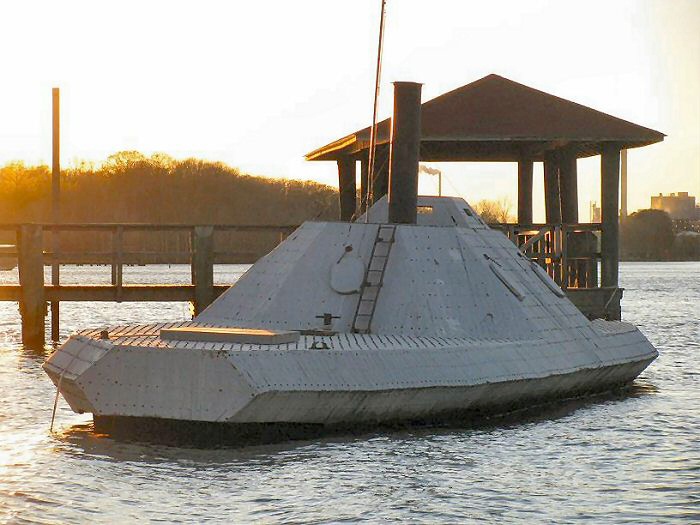
|
| Replica of CSS Albemarle |
| CSS Albemarle Ironclad Cannon |
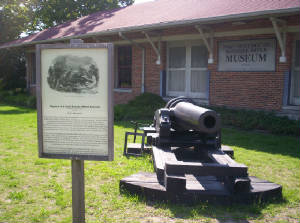
|
| CSS Albemarle Ironclad Cannon |
About 5 p.m. the engagement commenced. The Albemarle made repeated attempts to ram her huge antagonist,
but her slow speed prevented. The enemy poured broadside after broadside into her; but even the 100-pound rifled projectiles
and the 9-inch solid shot failed to penetrate her shield. The Sassacus rammed her just abaft the shield, but without effect.
In return, she received from the Albemarle a 100-pound Brooke
rifle-shot, which passed through one of her boilers, scalding many of her crew, and sending her out of action, disabled. The
Miami made no use of her torpedo and the seine accomplished
nothing. The Albemarle kept up a constant fire, though one
of her guns was badly cracked. Finding it impossible to capture the Albemarle, the Federal fleet discontinued the action at
7:30 p.m., and the unconquerable little ram made her way slowly back to Plymouth.
The total loss in the Federal vessels was 29. We have no returns of the Albemarle's
loss.
As the Confederate navy department was building an ironclad ram
on the Neuse River, the Albemarle now awaited her co-operation. On the night of October 27, 1864, she was sunk while
lying at the wharf at Plymouth, by a torpedo boat under the
command of the heroic Lieut. W. B. Cushing, U. S. N., one of the most brilliant exploits in naval annals. At the time, the
Albemarle was commanded by Lieut. A. F. Warley; Commander
Cooke, who had been promoted to captain, having retired from ill health. After the destruction of the Albemarle
the town of Plymouth fell again into the enemy's hands.
Source: The Confederate Military History, Volume 12, Chapter XI
Recommended
Reading: The Hunt for the Albemarle: Anatomy
of a Gunboat War (Hardcover). Description: On a muddy waterway, once called the River of Death,
James Cooke and Charles Flusser met again after parting when the Civil War started. Once both navy lieutenants, they now were
the opponents in naval warfare. Confederate Navy Lieutenant James Cooke had as many years of active naval service as Charles
Flusser had years of living. Cooke was a devoted family man while Flusser was a bachelor with a mind for young Southern women,
whiskey, cigars, fast horses, and early promotion. Continued below...
The Confederate
ironclad Albemarle was the key to the river wars in North Carolina. Flusser's
search for this ship would determine the success or failure of the Union navy in securing the North Carolina coast and
rivers. James Cooke and the Confederates knew their only chance to break the blockade was with the new ironclad. The Hunt
for the Albemarle
is the dramatic story of these two men and their destiny. Both of these men shared one common characteristic. Each was willing
to die for the cause he believed was right.
Recommended
Reading: A History of Ironclads: The Power of Iron over Wood. Description: This
landmark book documents the dramatic history of Civil War ironclads and reveals how ironclad warships revolutionized naval
warfare. Author John V. Quarstein explores in depth the impact of ironclads during the Civil War and their colossal effect
on naval history. The Battle of Hampton Roads was one of history's greatest naval engagements. Over the course of two days
in March 1862, this Civil War conflict decided the fate of all the world's navies. It was the first battle between ironclad
warships, and the 25,000 sailors, soldiers and civilians who witnessed the battle vividly understood what history would soon
confirm: wars waged on the seas would never be the same. Continued below…
About the Author: John V. Quarstein is an award-winning author and historian. He is director
of the Virginia
War Museum in Newport News and chief historical advisor for The Mariners' Museum's new USS Monitor Center
(opened March 2007). Quarstein has authored eleven books and dozens of articles on American, military and Civil War history,
and has appeared in documentaries for PBS, BBC, The History Channel and Discovery Channel.
Recommended
Reading: Iron Afloat: The Story of the Confederate Armorclads. Description: William N. Still's book is rightfully referred to as the standard of Confederate Naval history.
Accurate and objective accounts of the major and even minor engagements with Union forces are combined with extensive background
information. This edition has an enlarged section of historical drawings and sketches. Mr. Still explains the political background
that gave rise to the Confederate Ironclad program and his research is impeccable. An exhaustive literature listing rounds
out this excellent book. While strictly scientific, the inclusion of historical eyewitness accounts and the always fluent
style make this book a joy to read. This book is a great starting point.
Recommended
Reading: A History of the Confederate Navy
(Hardcover). From Publishers Weekly: One of the most prominent European scholars of the Civil War weighs in with a provocative
revisionist study of the Confederacy's naval policies. For 27 years, University of Genoa history professor Luraghi (The Rise
and Fall of the Plantation South) explored archival and monographic sources on both sides of the Atlantic to develop a convincing
argument that the deadliest maritime threat to the South was not, as commonly thought, the Union's blockade but the North's
amphibious and river operations. Confederate Navy Secretary Stephen Mallory, the author shows, thus focused on protecting
the Confederacy's inland waterways and controlling the harbors vital for military imports. Continued below…
As a result,
from Vicksburg
to Savannah to Richmond, major
Confederate ports ultimately were captured from the land and not from the sea, despite the North's overwhelming naval strength.
Luraghi highlights the South's ingenuity in inventing and employing new technologies: the ironclad, the submarine, the torpedo.
He establishes, however, that these innovations were the brainchildren of only a few men, whose work, although brilliant,
couldn't match the resources and might of a major industrial power like the Union. Nor did
the Confederate Navy, weakened through Mallory's administrative inefficiency, compensate with an effective command system.
Enhanced by a translation that retains the verve of the original, Luraghi's study is a notable addition to Civil War maritime
history. Includes numerous photos.
Recommended
Reading: Confederate Ironclad 1861-65 (New Vanguard). Description: The creation of a Confederate ironclad fleet was a miracle of ingenuity,
improvisation and logistics. Surrounded by a superior enemy fleet, Confederate designers adapted existing vessels or created
new ones from the keel up with the sole purpose of breaking the naval stranglehold on the nascent country. Her ironclads were
built in remote cornfields, on small inland rivers or in naval yards within sight of the enemy. The result was an unorthodox
but remarkable collection of vessels, which were able to contest the rivers and coastal waters of the South for five years.
This title explains how these vessels worked, how they were constructed, how they were manned and how they fought.
Recommended
Reading: Naval Campaigns of the Civil War.
Description: This analysis of naval engagements during the War Between the States presents the action from the efforts at
Fort Sumter during the secession of South Carolina in 1860, through the battles in the Gulf of Mexico, on the Mississippi
River, and along the eastern seaboard, to the final attack at Fort Fisher on the coast of North Carolina in January 1865.
This work provides an understanding of the maritime problems facing both sides at the beginning of the war, their efforts
to overcome these problems, and their attempts, both triumphant and tragic, to control the waterways of the South. The Union
blockade, Confederate privateers and commerce raiders are discussed, as is the famous battle between the Monitor and the Merrimack. Continued below…
An overview
of the events in the early months preceding the outbreak of the war is presented. The chronological arrangement of the campaigns
allows for ready reference regarding a single event or an entire series of campaigns. Maps and an index are also included.
About the Author: Paul Calore, a graduate of Johnson and Wales University,
was the Operations Branch Chief with the Defense Logistics Agency of the Department of Defense before retiring. He is a supporting
member of the U.S. Civil War Center and the Civil War Preservation Trust and has also written Land Campaigns of the Civil
War (2000). He lives in Seekonk, Massachusetts.
Recommended Reading: Ironclads and Columbiads: The Coast (The Civil War in North Carolina)
(456 pages). Description: Ironclads and Columbiads
covers some of the most important battles and campaigns in the state. In January 1862, Union forces began in earnest to occupy
crucial points on the North Carolina coast. Within six months,
Union army and naval forces effectively controlled coastal North Carolina from the Virginia line south to present-day Morehead
City. Union setbacks in Virginia, however, led to the withdrawal of many
federal soldiers from North Carolina, leaving only enough Union troops to hold a few coastal strongholds—the vital ports
and railroad junctions. The South during the Civil War, moreover, hotly contested the North’s ability to maintain its
grip on these key coastal strongholds.
Recommended
Reading: Naval Strategies of the Civil War: Confederate Innovations and Federal Opportunism. Description: One of the most overlooked aspects of the American Civil War is the
naval strategy played out by the U.S. Navy and the fledgling Confederate Navy, which may make this the first book to compare
and contrast the strategic concepts of the Southern Secretary of the Navy Stephen R. Mallory against his Northern counterpart,
Gideon Welles. Both men had to accomplish much and were given great latitude in achieving their goals. Mallory's vision of
seapower emphasized technological innovation and individual competence as he sought to match quality against the Union Navy's
(quantity) numerical superiority. Welles had to deal with more bureaucratic structure and to some degree a national strategy
dictated by the White House. Continued below...
The naval blockade
of the South was one of his first tasks - for which he had but few ships available - and although he followed the national
strategy, he did not limit himself to it when opportunities arose. Mallory's dedication to ironclads is well known, but he
also defined the roles of commerce raiders, submarines, and naval mines. Welles's contributions to the Union effort were rooted
in his organizational skills and his willingness to cooperate with the other military departments of his government. This
led to successes through combined army and naval units in several campaigns on and around the Mississippi River.
|

